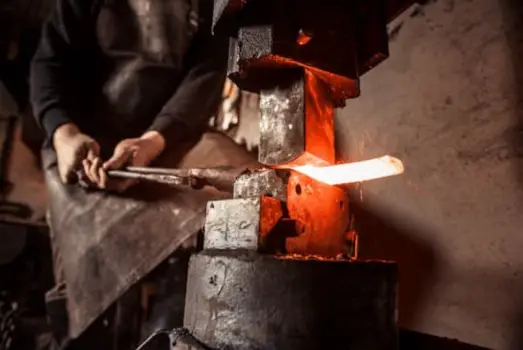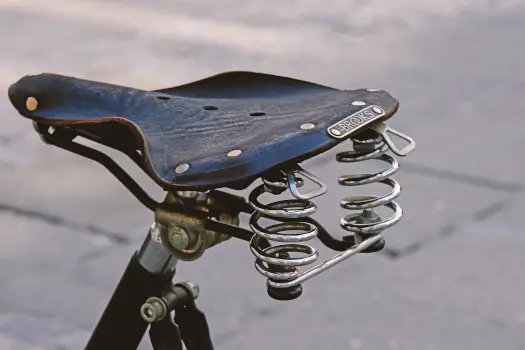In physics and mechanics, compression refers to the application of a compressive force to an object, leading to its deformation by squeezing or pressing inward and resulting in a decrease in size or volume. This force is encountered across diverse fields, including structural engineering, material testing, and hydraulic systems, where objects or materials are subjected to external pressure. In mechanical systems, compression is often strategically employed to enhance stability, durability, and functionality. Whether in the controlled compression of materials for testing purposes or the intentional application of force to create a secure seal, the concept of compression plays a crucial role in understanding and manipulating the physical properties of objects in various scientific and engineering applications.
Examples
Spring

When a train runs on the rail track, the springs fixed in the wheels of the train experience a compression force. This force is generated by the weight of the train pressing down on the springs, causing them to compress and store potential energy. The compressed springs play a crucial role in stabilizing the train, absorbing shocks, and maintaining contact between the wheels and the track. Therefore, the compression force in the springs is essential for ensuring the smooth and efficient movement of the train.
Suspension bridge

When vehicles pass over a suspension bridge, the weight of the vehicles exerts a downward force, resulting in compression. This compression force is an essential aspect of the bridge’s structural integrity. The bridge components, such as columns and beams, are designed to withstand and distribute this compression force. It is through this design that the bridge remains stable and safe for vehicles to cross.
Hydraulic press

A hydraulic press is a machine that applies a compression force to crush materials placed within it. When the hydraulic press is activated, it generates a powerful compression force that acts on the material, causing it to be crushed. The ability of the hydraulic press to generate and control this compression force makes it suitable for various applications, such as metal forming, material testing, and industrial processes that require precise force application.
Shoe sole

When a person walks or runs on the ground, their foot exerts a downward force on the shoe sole, resulting in compression. This compression causes the shoe sole to temporarily compress under the weight and impact of the person’s movement, allowing it to absorb and distribute the forces generated during walking or running. As a result, the shoe provides cushioning and support to the foot, helping to reduce the impact on the feet, enhance comfort, and provide stability during various activities.
Mattress

When a person sleeps on a bed, their body applies a compression force on the mattress, causing the springs inside to compress. This compression force allows the mattress to support the body’s weight and distribute it evenly. By compressing the springs, the mattress conforms to the body’s shape and helps relieve pressure points, resulting in a comfortable and restful sleep.
Sponge

When a sponge is pressed by hand, the applied compression force changes its shape. The hand applies pressure to the sponge, causing it to deform temporarily. Once the external force is removed, the sponge’s elastic properties allow it to naturally restore its original shape. This ability to regain shape after compression is a characteristic of elastic materials like sponges.
Bicycle pump

When a person operates a bicycle pump, they exert a compression force with their hand, causing the springs inside the pump to temporarily compress. The applied force on the pump results in the compression of the springs, enabling the pump to build up pressure and subsequently inflate the tire or object being pumped.
Bicycle seat

When a person sits on a bicycle seat, their body exerts a compression force on the seat, causing the springs underneath the seat to temporarily compress. This compression allows the seat to absorb the impact and provide a more comfortable riding experience. The springs’ ability to compress and then regain their original shape helps in cushioning the rider from bumps and vibrations during cycling.
Related
- Force examples
- Normal force examples
- Balanced force examples
- Unbalanced force examples
- Applied force examples
- Compression force examples
Image credit
- The stock photos used in this post are sourced from platforms like Pexels, Pixabay, Canva, etc. Due to the age of the images, their specific origins remain unknown.
External links
- What is Compression Force? – Tekscan
- What are examples of compression force? – Quora
- Compression Force – Fujifilm Prescale – Sensor Products
- What is Compression Force? – Morehouse Instrument Company
- Compressive Stress: Definition, Unit, Formula, and Example – Xometry
- Compressive forces on lower body extremities – SeleceFlex
- Which type of force are tension and compression? – Homework.Study.com
- Compression (physics) – Wikipedia
- What Is Compression Force? – MT Copeland
- Example of compression force? – Answers
- Compression | Pressure, Force & Volume – Britannica
- Which of the following examples demonstrates a compression force? – Brainly
Deep
Learnool.com was founded by Deep Rana, who is a mechanical engineer by profession and a blogger by passion. He has a good conceptual knowledge on different educational topics and he provides the same on this website. He loves to learn something new everyday and believes that the best utilization of free time is developing a new skill.
